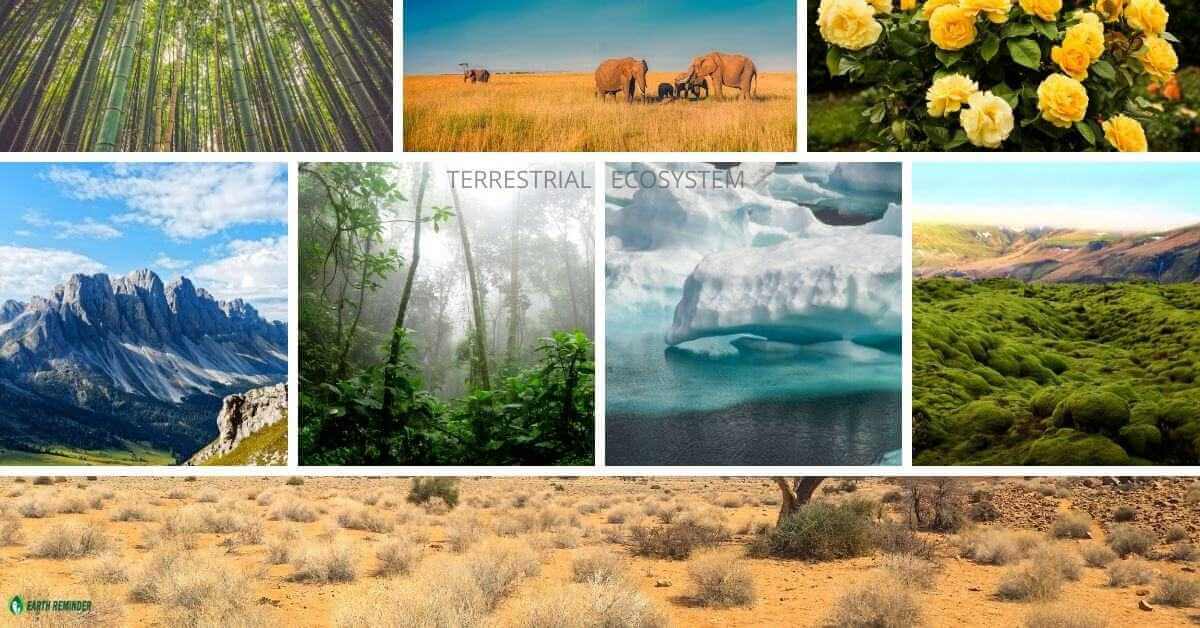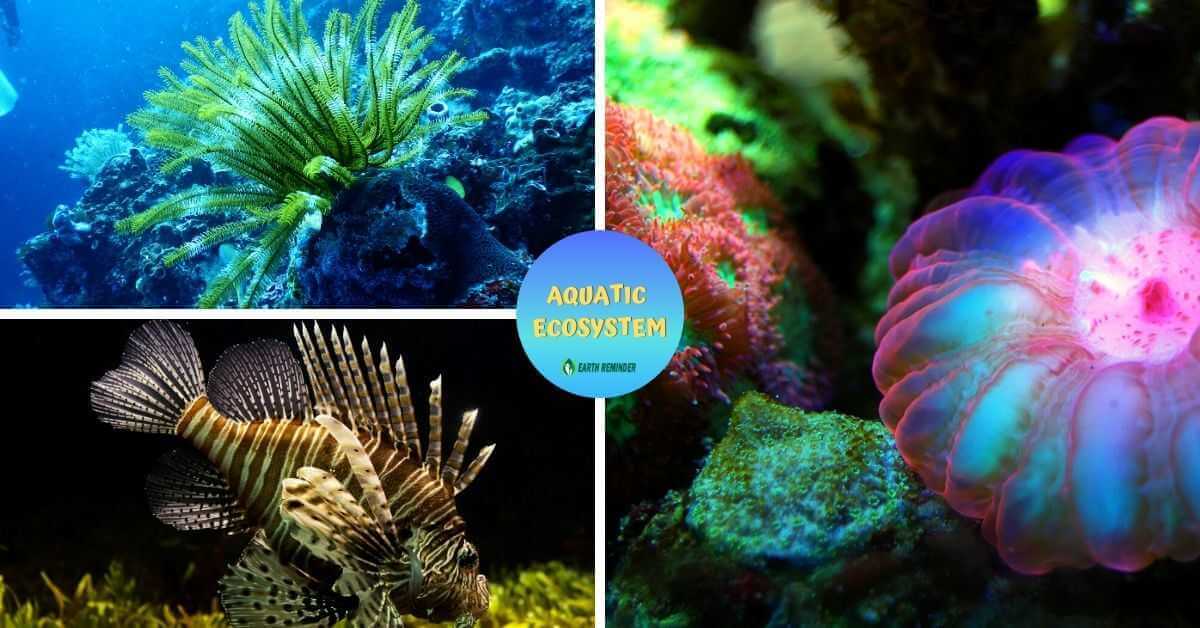Types of Ecosystems
Different Ecosystem Types -Terrestrial and Aquatic with their sub-ecosystems
The community of living & non-living organisms and even the environment around that community is termed as an ecosystem. There is a specific area for different types of ecosystems, and all the organisms & the environment interact with each other in that particular area.

The atmosphere, sunlight, water, soil, animals, living organisms, non-living organisms, etc. all together make an ecosystem in a specific natural setting.
Let’s say, for example – Aquatic ecosystems: where all the water animals/mammals, micro-organisms, non-living things, etc. survive together underwater.
In the terrestrial ecosystem the land animals and the environment around them make a different ecosystem suitable for them.
The sun is termed as the primary source of energy, as it is primarily required to flow an ecosystem. This energy flows from one organism to another in the form of a food chain.
For example – Plants get sunlight to make their food by the process of photosynthesis. The herbivorous animals get this energy when they eat plants, and the carnivorous animals get energy when they eat other animals. In this way, the energy flows in an ecosystem.
What Are the Types of Ecosystems?
The broad category of the ecosystem is mainly of two types – Terrestrial and Aquatic. In this article, we will discuss the different types of ecosystems classified under terrestrial and aquatic ecosystem with main characteristics.

Terrestrial Ecosystem
The terrestrial ecosystem refers to the ecosystem of different land forms only. The atmosphere in the terrestrial ecosystem is quite different from the aquatic ecosystem.
The major types of ecosystems are forest, desert, rain forest, grassland, tundra, savanna and mountain ecosystem.
- Rain-forest Ecosystem
The atmosphere in the rain forest regions is very adorable. This ecosystem is covered with lush green views all around this region. The excessive rainfall provides a dense environment in the rain forest ecosystem. This is why you can find different varieties of plants & animals in the rain forest ecosystem.
- Desert Ecosystem
Desert ecosystem has a high amount of flora & fauna found in this region. The desert ecosystem has covered almost 17% of the Earth’s surface. Excessive temperature, extreme sunshine, less water available, etc. do not allow a variety of plants & animals to live in a desert ecosystem. You can find some plants such as cactus in the desert ecosystem. These types of plants can conserve water as much as they can. In this region, we can find animals like camels, reptiles, a few insects, etc.
- Forest Ecosystem
The forest ecosystem has a huge variety of flora and fauna living together in a specific area. There are different types of forest ecosystems based on climatic conditions such as tropical, temperate, boreal, etc.
In a tropical ecosystem, we can find a large variety of vegetation as compared to another terrestrial ecosystem; This is the reason that you will always find tropical regions loaded with lush green landscapes.
On the other hand, the temperate regions the ecosystem may be coniferous, deciduous, or a combination of both. The forest ecosystem is one of the crucial terrestrial ecosystems that provide shelter to thousands of plant & animal species.
- Tundra Ecosystem
There is limited life in the tundra ecosystem due to the harsh environment of this region. The tundra region refers to the lower altitudes of polar areas. Most of the time in a year, the land in this region is covered with snow, which makes the survival very tough; This is the reason for the limited flora & fauna found in this kind of ecosystem.
- Savanna Ecosystem
Most of people have a perception that savannas are similar to deserts. The savannas ecosystem is a little different from the desert ecosystem due to the amount of rainfall in savannas. Savannas get more rainfall as compare to the desert ecosystem, which supports the life of the flora & fauna.
- Grassland Ecosystem
As the name suggests, the grassland ecosystem mainly contains grasses along with some species of shrubs & trees. Grassland is a perfect region for grazing animals. The atmosphere in the grassland ecosystem is quite pleasant, and the climatic conditions are very similar to semi-arid regions. The mostly found organisms in the grassland ecosystem are grazing animals, herbivorous, insectivorous, etc. Tropical & temperate are typical regions of the grassland ecosystem.
- Mountain Ecosystem
The mountain ecosystem is packed with a huge variety of plants & animals. However, survival in mountain ecosystem is quite challenging due to alpine vegetation. The animals found on higher altitudes are covered with long & thick fur to protect themselves from cold. The animals of the mountain ecosystem also have to spend a long period of hibernation. The life in mountain ecosystem is quite tough in terms of habitats & survival.
Aquatic Ecosystem
The ecosystem found in different water bodies is known as an aquatic ecosystem. The major types of aquatic ecosystems are – marine ecosystems and freshwater ecosystems. Let’s understand the aquatic ecosystem with characteristics in brief-

- Marine Ecosystem
Marine ecosystem covers almost 70% of the area on Earth’s surface, hence known as one of the biggest kinds of ecosystems on the Earth. Water is the main component of the marine ecosystem, which contains various minerals & salt dissolved in it.
Many organisms such as sharks, cephalopods, brown algae, echinoderm, corals, dinoflagellates, etc. contribute to be a part of the marine ecosystem.
- Freshwater Ecosystem
Freshwater is another type of aquatic ecosystem that covers less area as compared to the marine ecosystem. The freshwater ecosystem covers almost 0.8% of the Earth’s surface. The major kinds of freshwater ecosystems are lentic, lotic, and wetlands.
Lentic ecosystem refers to stagnant water bodies such as ponds, lakes, etc. whereas the lotic ecosystem means fast-flowing water bodies such as a river. On the other hand, in wetland areas, the land becomes saturated and remains for a long period.
The freshwater ecosystem is a home for various fishes, reptiles, amphibians, etc. The fast-flowing water bodies have more dissolved oxygen as compare to slow-flowing water bodies. Hence, the fast-flowing water bodies support significant diversity.
If you think you can add on to it, Make a reply in the comment section. Share it with your friends to increase your knowledge altogether.